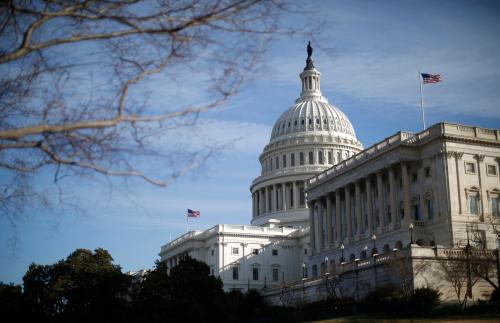The Congressional Budget Office’s new Budget and Economic Outlook provides a useful update on the state of the economy and the budget. While the headline news is the return of trillion-dollar annual deficits, there is much more to consider. Here are four take-aways from the latest projections:
1. Interest rates have fallen and will remain low.
Over the past year, CBO has sharply lowered its projected future interest rates. Last year, CBO projected that in 2029, the yield on 10-year Treasuries would be 3.8 percent; today, it’s 3.0 percent. Last year, it projected the yield on 3-month Treasuries would be 2.8 percent in 2029; today, 2.4 percent. All else equal, lower interest rates are good for the federal budget, because the government is a large net borrower. Lower interest rates reduce net interest payments on any given amount of debt and reduce the chance of a debt spiral. This gives the government more fiscal space to respond to current social and economic needs. But that ends the “good news” portion of this update.
2. The long-term baseline budget situation has deteriorated significantly.
While the debt-to-GDP ratio currently stands at about 81 percent, CBO projects that the figure will rise to 174 percent by 2049 and 180 percent by 2050, far exceeding any figure in U.S. history. Last year, CBO projected a 2049 debt-to-GDP ratio of “just” 144 percent, fully 30 percentage points lower than the current estimate. Note that the increase in the 2049 projected debt-to-GDP ratio occurred despite the assumption that interest rates will be markedly lower than previously thought. The debt will rise because recent legislative changes (after the 2017 tax cut) reduced revenues and boosted spending, and because CBO reduced its projections of future GDP growth rates.
3. Plausible scenarios show even higher debt-to-GDP accumulation.
CBO is required to build a baseline under formulaic rules that assume current law prevails. This does not, in my opinion, provide an accurate view of where we are likely to be headed if current policies continue. The law says tax cuts will expire, but will they? Congress recently killed three tax increases related to health insurance that hadn’t yet taken effect; in its current law baseline, CBO had assumed otherwise. If, as current policy projections assume, Congress extends the portions of the 2017 Tax Cut and Jobs Act that are scheduled to expire in the coming decade, the projected debt-to-GDP ratio would exceed 200 percent by 2050.
4. The projected deficits are full-employment deficits and thus are more troubling than they might appear to be at first glance.
Both the state of the economy and fiscal policy contribute to deficits. For example, during the Great Recession, GDP shrank and tax revenues fell, raising the deficit. Then Congress cut taxes and raised spending to fight the recession, raising the deficit further (and helping the economy recover more quickly). In order to isolate the effects of policy, analysts construct “full employment” deficits that show what the deficit would be if the economy were at full employment. CBO’s baseline shows deficits ranging for 4.3 percent to 5.4 percent of GDP. They are essentially full employment deficits. (Over the next 10 years, CBO projects that actual GDP and the GDP that would prevail at full employment will be approximately equal.) In the past, when the economy reached full employment, deficits came down rapidly. The U.S. has never had consistently high deficits at times of full employment. This is about to change, however, as shown in the Figure (which contains my estimates of future full employment deficits). This indicates a fundamental imbalance between spending and taxes that is now “baked into” the federal budget.

So, where does that leave us? We do not face an imminent fiscal crisis. But we are on an unsustainable course. The only good thing about latest fiscal outlook is that interest rates are expected to remain low.
For more information on our fiscal situation and how to address it, see my book Fiscal Therapy: Curing America’s Debt Addiction and Investing in the Future.
I would like to thank Grace Enda and Claire Haldeman for providing research assistance.
The Brookings Institution is committed to quality, independence, and impact.
We are supported by a diverse array of funders. In line with our values and policies, each Brookings publication represents the sole views of its author(s).







Commentary
Trillion dollar deficits as far as the eye can see: Four take-aways from CBO’s new budget outlook
February 3, 2020